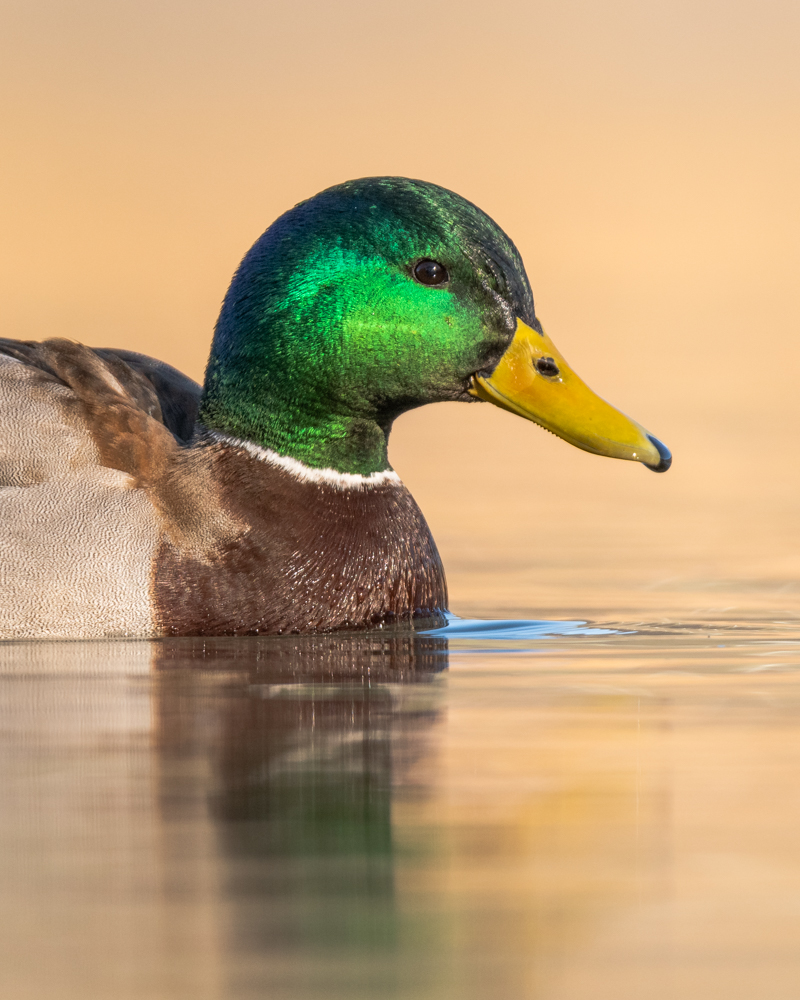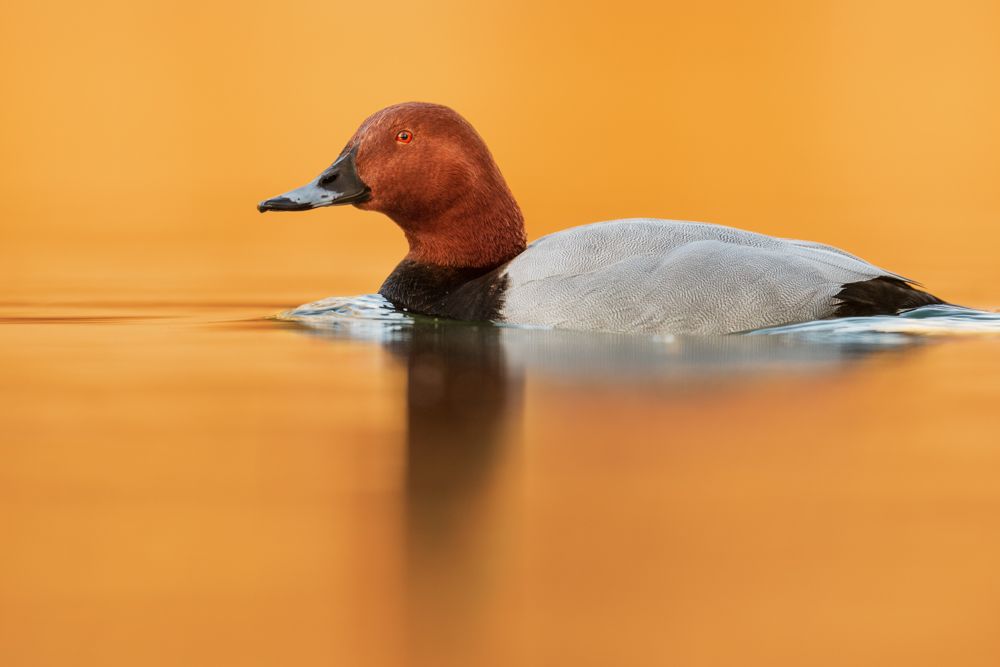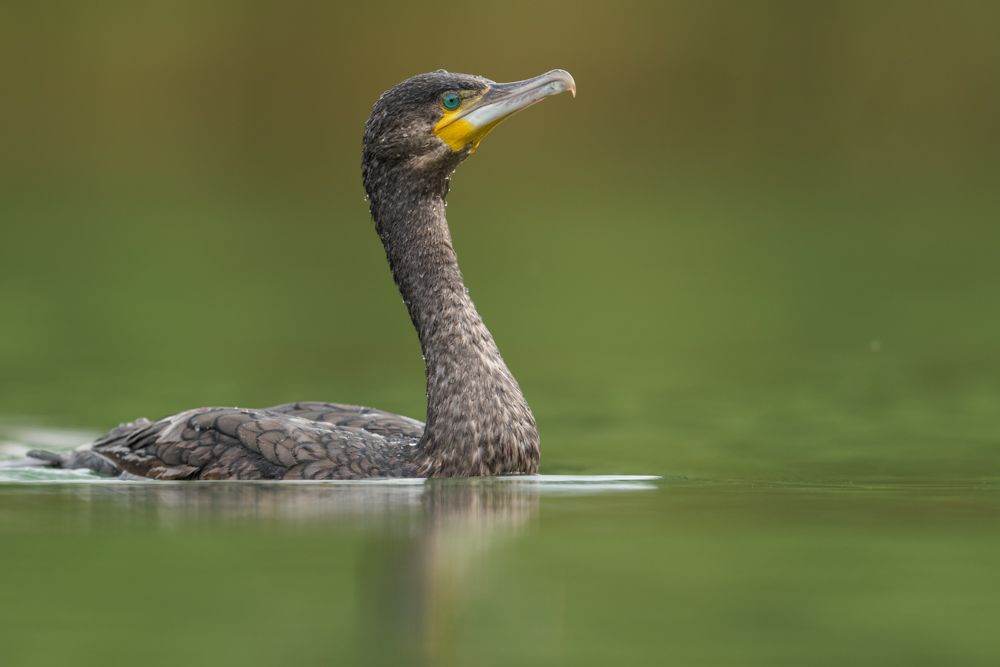Mallard (Anas platyrhynchos)
Profile
Scientific name: Anas platyrhynchos
Class: Birds
Order: Anseriformes
Family: Anatidae
Length: 50-65cm
Wingspan: 81-91cm
Weight: 850-1400g
Distribution: Northern hemisphere
Breeding population CH: 20'000-30'000 pairs
Habitat: Waters of all kinds
Migration behaviour: Resident bird, short-distance migrant
Appearance & Identification
The mallard male can be identified by its shimmering green head in a breeding plumage. The head feathers are actually black, but they are iridescent and shimmer in all possible colours when hit by sunlight with the right angle. Besides the typical green colouring of the head, it can also take on a bluish or violet colouring. But this depends very much on the light conditions. In backlight or diffuse light, the head appear rather purple to dark blue. Other good identifying features are the yellow beak with a black nail (tip of the beak), the brown chest or the white neck ring. This separates the iridescent head feathers from the brown chest. The speculum is blue on both male and female mallard and has a white border around it.
In summer, the mallard males moult into an eclipse plumage. This is less conspicuously coloured and resembles the plumage of the female. The female of the mallard also renews its feathers regularly, but the plumage looks the same all year round. The males in the eclipse plumage can be easily distinguished from the females by their yellow bill. Also, the head pattern of the males in the eclipse plumage is somewhat more contrasting than it would be on females.
Typical for dabbling ducks, the females are patterned brown. The beak is bicoloured and consists of orange and black parts. However, beak patterns vary from individual to individual.
Risk of confusion
It is relatively difficult to identify female dabbling ducks. I have described the details of each species in an earlier blog article.
Female mallards and gadwalls are the most difficult to distinguish. The only differences are the differently coloured speculums and the beak. Mallard males and females have a blue speculum with a white border. The speculum of the gadwall is only white. Both females have an orange and black bill. However, the two colours are clearly separated on the female gadwall, while the female mallard duck has patterns and colour gradients.
Habitat
The mallard is very undemanding in terms of habitat choice. It ranges from harbour areas to small park ponds and torrential streams. Once I could already observe a pair of mallards in the middle of a canyon.
Distribution in Switzerland
The mallard is very widespread in Switzerland and is also quite common. A large proportion of the birds that breed in the country can be traced back to released birds. Particularly in the Swiss plateau (Mittelland), the mallard can be found on almost all waters, both in summer and winter. In the Alps, the mallard is rather rare. The total population in Switzerland counts about 20’000 to 30’000 breeding pairs. In recent years this number has neither increased nor decreased and remains relatively stable.
A large proportion of our breeding birds spend the winter further south. Those include especially the ‘natural’ population. The population that traces back to the released birds, stay here the whole year. The number of winter visitors from the north is smaller than those who have flown further south hence why there are more mallards in Switzerland during the summer months than in winter. The winter population is estimated at about 40'000 individuals.
Diet
The mallard naturally feeds mainly on plants. However, it also eats insects, snails and other small animals. In areas close to settlements the mallard also feeds on bread. Although this provides the ducks with easy energy, it is very unhealthy and harmful due to its high salt content.
Breeding behaviour
As with all ducks, only the mother is responsible for raising the young. The males gather at the beginning of summer and move to areas rich in food, while the females stay behind in the breeding area. The mallard female lays between 6 to 15 eggs which she incubates for about 28 days. The females do not have a lot of demands on the nest location. There are even broods in plant pots, in the corners of houses or hidden under the garden hedge. After the young have hatched, they leave the nest after a few hours. This behaviour is also known as "nest escapees". The young are protected and guided by their mother. However, the young have to search and take in the food themselves. After about 50 to 60 days the young are able to fly and become independent.
Migration behaviour
Mallards are resident birds but also short-distance migrants. In Switzerland, some ducks migrate further south. The ones, which are the result of released birds, remain in Switzerland all year round. These resident birds are joined by winter visitors from the far north. In summer, however, there are still more mallards in Switzerland during the summer months than in winter.
Photographing the mallard
Mallards are not shy and almost tame. Especially in the settlement area they are ideal to start taking pictures of water birds. I have already written an article about photographing waterfowl in winter. There I show you why you should always take pictures at eye level, how important the location is or how you can get close to ducks.
Resources
The population figures, length, weight and wingspan correspond to the data of the Vogelwarte Sempach
Information on behaviour, distribution etc. is based on my own observations and was supplemented with information from the following sources:
The Birds of Switzerland (2007) Lionel Maumary et al.
Swiss Breeding Bird Atlas 2013-2016
The Cosmos Bird Guide (2017) Lars Svensson et al.

























